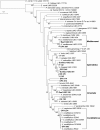Abundance and Multilocus Sequence Analysis of Vibrio Bacteria Associated with Diseased Elkhorn Coral (Acropora palmata) of the Florida Keys
- PMID: 29079623
- PMCID: PMC5752851
- DOI: 10.1128/AEM.01035-17
Abundance and Multilocus Sequence Analysis of Vibrio Bacteria Associated with Diseased Elkhorn Coral (Acropora palmata) of the Florida Keys
Abstract
The critically endangered elkhorn coral (Acropora palmata) is affected by white pox disease (WPX) throughout the Florida Reef Tract and wider Caribbean. The bacterium Serratia marcescens was previously identified as one etiologic agent of WPX but is no longer consistently detected in contemporary outbreaks. It is now believed that multiple etiologic agents cause WPX; however, to date, no other potential pathogens have been thoroughly investigated. This study examined the association of Vibrio bacteria with WPX occurrence from August 2012 to 2014 at Looe Key Reef in the Florida Keys, USA. The concentration of cultivable Vibrio was consistently greater in WPX samples than in healthy samples. The abundance of Vibrio bacteria relative to total bacteria was four times higher in samples from WPX lesions than in adjacent apparently healthy regions of diseased corals based on quantitative PCR (qPCR). Multilocus sequence analysis (MLSA) was used to assess the diversity of 69 Vibrio isolates collected from diseased and apparently healthy A. palmata colonies and the surrounding seawater. Vibrio species with known pathogenicity to corals were detected in both apparently healthy and diseased samples. While the causative agent(s) of contemporary WPX outbreaks remains elusive, our results suggest that Vibrio spp. may be part of a nonspecific heterotrophic bacterial bloom rather than acting as primary pathogens. This study highlights the need for highly resolved temporal sampling in situ to further elucidate the role of Vibrio during WPX onset and progression.IMPORTANCE Coral diseases are increasing worldwide and are now considered a major contributor to coral reef decline. In particular, the Caribbean has been noted as a coral disease hot spot, owing to the dramatic loss of framework-building acroporid corals due to tissue loss diseases. The pathogenesis of contemporary white pox disease (WPX) outbreaks in Acropora palmata remains poorly understood. This study investigates the association of Vibrio bacteria with WPX.
Keywords: Acropora palmata; Caribbean; Vibrio; bacterial bloom; coral disease; pathobiome; pathobiont; white pox.
Copyright © 2018 American Society for Microbiology.
Figures




References
-
- Tout J, Siboni N, Messer LF, Garren M, Stocker R, Webster NS, Ralph PJ, Seymour JR. 2015. Increased seawater temperature increases the abundance and alters the structure of natural Vibrio populations associated with the coral Pocillopora damicornis. Front Microbiol 6:403–412. doi: 10.3389/fmicb.2015.00432. - DOI - PMC - PubMed
Publication types
MeSH terms
Substances
Grants and funding
LinkOut - more resources
Full Text Sources
Other Literature Sources
Miscellaneous

